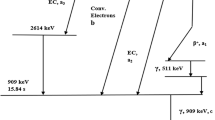Abstract
We studied 27 β+ radionuclides taking into account some of their variants encoding information of their production, such as integral yield, threshold energy and energy of projectiles used to generate them; these radionuclides are of current use in clinical diagnostic imaging by positron emission tomography (PET). The study was conducted based on physical, physico-chemical, nuclear, dosimetric and quantum properties, which characterise the β+ radionuclides selected, with the aim of finding meaningful relationships among them. In order to accomplish this objective the mathematical methodology known as formal concept analysis was employed. We obtained a set of logical assertions (rules) classified as implications and associations, for the set of β+ radionuclides considered. Some of them show that low mass defect is related to high and medium values of maximum β+ energy, and with even parity and low mean lives; all these parameters are associated to the dose received by a patient subjected to a PET analysis.


Similar content being viewed by others
Notes
An enriched target allows obtaining a high purity radionuclide; however the process is expensive. Even though, for the production of 18F in a cyclotron facility, one of the most widely used β+ radionuclide in PET; it is necessary to use an expensive enriched target (H 182 O, 18O > 95%).
In our study, the maximum energy of projectiles was divided into three ranges: low (E < 14.7 MeV), medium (E = 14.8–59.0 MeV) and high energies (E = 60–110 MeV) (Table 4).
Endpoint energy of a β+ decay is the kinetic energy of all positrons emitted through β+ decay. Since the surplus in energy has to be divided between the positron and the neutrino, there is a continuous energy spectrum for the positron up to the maximum energy [16].
References
Sahoo S, Sahoo S (2006) Physics Education 5-11. http://physics.unipune.ernet.in/~phyed/23.1/23.1_SSahoo.pdf. Accessed 21 Feb 2013
Final Report Second of two 2008 NSAC Charges on the isotope development and production for research and applications program. Isotopes for the nation`s future along range plan. http://www.isotopes.gov/outreach/reports/NSACI_II_Report.pdf. Accessed 20 Feb 2013
Kassis A (2008) Semin Nucl Med 38:358–366
Ishiwata K, Kimura Y, Oda K, Ishii K, Sakata M, Kawasaki K, Nariai T, Suzuki Y, Ishibashi K, Mishina M, Hashimoto M, Ishikawa M, Toyohara J (2010) Geriatr Gerontol Int 10:S180–S196
Camargo EE (2001) J Nucl Med 42:611–623
Carrió I, González P, Storch M, Canessa J, Mitjavila M, Massardo T (2003) Medicina nuclear. Aplicaciones clínicas, Masson. S.A., Barcelona. ISBN 84-458-1291-2
Kipper MS (2002) Appl Radiol 31:18–41
Quintero NY, Restrepo G, Cohen IM (2013) J Radioanal Nucl Chem 195:823–833
Brüggemann R, Drescher-Kaden U (2003) Einführung in die modellgestützte Bewertung von Umwelt-chemikalien. Springer, Heidelberg
Restrepo G, Mesa H, Llanos E (2006) J Math Chem 39:401–416
Romesburg HCH (2004) Cluster Analysis for researchers. Lulu Press, Raleigh
Li Z, Ding Q, Zhang W (2011) Commun Comput Inf Sci 134:483–488
Ferreira L, Hitchcock DB (2009) Commun Stat 8:1925–1949
XLSTAT (2009) http://xlstat-2009.fyxm.net/. Accessed 22 May 2012
Restrepo G, Mesa H, Llanos EJ (2007) J Chem Inf Model 41:761–770
Paans AMJ, Waarde AV, Elsinga PH, Willemsen ATM, Vaalburg W (2002) Methods 27:200
Pagani M, Stone-Elander S, Larsson SA (1997) Eu J Nucl Med Mol Imaging 24:1301–1327
Ziessmann H, O′Malley J, Thrall JH (2007) Medicina nuclear: los requisitos en radiología, 3rd edn. Elsevier, España
Uribe E, Daza M, Restrepo G (2005) WSEAS Transactions on Information science and applications 2:1085–1090
Priss U (2006) In: Cronin B (ed) Annual Review of Information Science and Technology ASIST, 40: 521–543
Park HM (2008) Univariate Analysis and Normality test using SAS Stata, and SPSS. Working paper. The University Information Technology Services (UITS) Center for Statistical and Mathematical Computing, Indiana University, USA
Osborne JW (2010) Pract Assess Res Eval 15:1–9
Stephens LJ (1998) Theory and problems of beginning statistics (Schaum′s outline series). New York, McGraw-Hill
Yevtushenko, SA (2000) System of data analysis “Concept Explorer”. (In Russian). Proceedings of the 7th national conference on Artificial Intelligence KII-2000, 127–134
Lenca P, Meyer P, Vaillant B, Lallich S (2008) Eur J Oper Res 184:610–628
McNicholas PD, Murphy TB, O′Regan M (2008) Comput Stat Data An 52:4712–4721
Kannan S, Bhaskaran R (2009) IJCSI 6:35–43
Kannan S, Bhaskaran R (2010) J. Computing 2:8–15
Ikonomovska E, Gjorgjevik D, Loskovska S (2007) Using Data Mining Technique for Coefficient Tuning of an Adaptive Tabu Search EUROCON. The International Conference on “Computer as a Tool”. Warsaw, September 9–12; p. 706–713
Shivarudrapa V, Vimalnath KV (2005) Bullet Mater Sci 28:327
Qaim SM (2011) In: Vértes A, Nagy S, Klencsár Z, Lovas RG, Rösch F (eds) Handbook of Nuclear Chemistry. Springer Science Business Media B.V. doi:10.1007/978-1-4419-0720-2-39
Qaim SM (2011) Radiochim Acta 99:611–625
Berardi M, Appice A, Loglisci C, Leo P (2006) Foundations of intelligent systems. Lect Notes Comput Sci 4203:369–378
Acknowledgments
N. Y. Quintero thanks G. A. Aranda-Corral and M. Bal for their support and discussions about the application of FCA. Several scientists belonging to FCA community cited in the references are acknowledged for their enriching comments. G. Restrepo specially thanks the Universidad de Pamplona for the financial support to conduct this research.
Author information
Authors and Affiliations
Corresponding author
Rights and permissions
About this article
Cite this article
Quintero, N.Y., Restrepo, G. & Cohen, I.M. Relating β+ radionuclides’ properties by order theory. J Radioanal Nucl Chem 298, 1937–1946 (2013). https://doi.org/10.1007/s10967-013-2685-6
Received:
Published:
Issue Date:
DOI: https://doi.org/10.1007/s10967-013-2685-6




